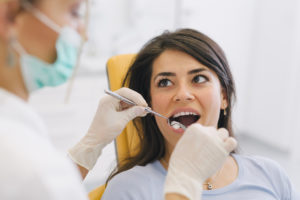 Following tooth loss, there are more negative oral health effects than just your missing tooth and possible changes to your appearance. Actually, the bulk of the oral health concerns are happening below the surface of your smile. When you lose one or more teeth, the supportive gum and bone tissue are no longer stimulated. Over time, this tissue is lost, leading to changes in facial shape, dental drift, and further tooth loss. Dental implant supported tooth replacement is a great option to replace the lost root structures, but when supportive tissues are already lost, dental implants may not successfully fuse with the jawbone. Traditionally, dentists would use bone or gum tissue grafts to create the necessary support for the implant. Guided bone & tissue regeneration (GBTR) is an innovative method used to improve bone density and gum tissue volume to increase your chances for successful dental implant placement.
Following tooth loss, there are more negative oral health effects than just your missing tooth and possible changes to your appearance. Actually, the bulk of the oral health concerns are happening below the surface of your smile. When you lose one or more teeth, the supportive gum and bone tissue are no longer stimulated. Over time, this tissue is lost, leading to changes in facial shape, dental drift, and further tooth loss. Dental implant supported tooth replacement is a great option to replace the lost root structures, but when supportive tissues are already lost, dental implants may not successfully fuse with the jawbone. Traditionally, dentists would use bone or gum tissue grafts to create the necessary support for the implant. Guided bone & tissue regeneration (GBTR) is an innovative method used to improve bone density and gum tissue volume to increase your chances for successful dental implant placement.
What is GBTR?
GBTR is a unique method for grafting bone or soft tissue to recreate lost bone and gums. Like traditional bone grafts, we begin by making a small incision in the gum tissue. Then, we place a small amount of graft tissue. What makes GBTR unique is the application of a barrier membrane that shapes the developing tissue and accelerates growth.
How Does GBTR Work?
Usually slow developing gum and bone tissue can take months or years to grow following traditional tissue grafts, and it’s difficult to control the shape of the added tissues. That’s where GBTR comes in. The barrier membrane significantly accelerates the growth of replacement tissue, and most importantly, it ensures the grafted gum and bone recreate the proper shape to support a dental implant post.
Will I Need GBTR Before Replacing Missing Teeth?
Not every patient needs tissue grafts. In most cases, you will only need bone or soft tissue grafting if you’ve waited several years to replace a missing tooth or you’ve experienced advanced tooth loss. However, some patients naturally have less supportive tooth structure, and before they will be able to achieve successful implantation, tissue grafts are necessary. Before beginning a dental implant tooth replacement plan, ask your dentist whether or not bone or gum tissue grafts will improve your chances for successful implant placement.
Meet the Dent-Plant Dental Implant Center Team
If you’ve been told you don’t have adequate gum tissue or jawbone density to support a dental implant, the Dent-Plant Dental Implant Center team in Tysons may be able to help you with guided bone tissue regeneration. Call our Tysons’ dental office to schedule a tooth replacement consultation. We’ll evaluate your smile, review your tooth replacement options, and help you create a personalized treatment plan that fits your unique needs.

